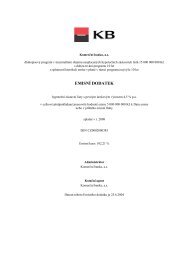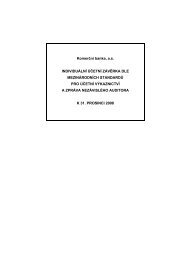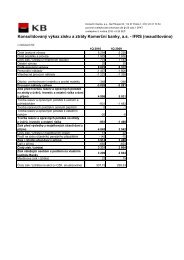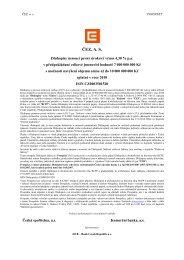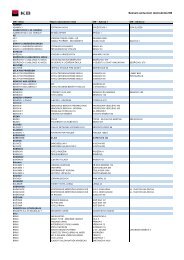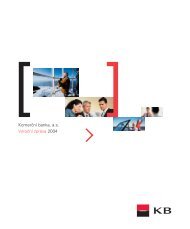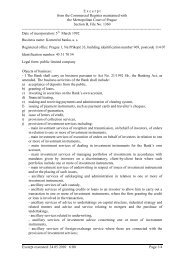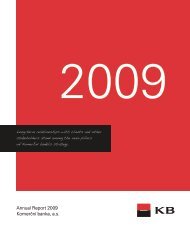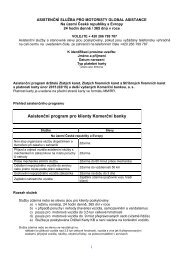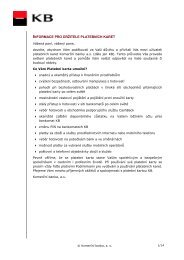KB prezent. angl - Komerční banka
KB prezent. angl - Komerční banka
KB prezent. angl - Komerční banka
You also want an ePaper? Increase the reach of your titles
YUMPU automatically turns print PDFs into web optimized ePapers that Google loves.
Risk Management<br />
Risk management at <strong>Komerční</strong> <strong>banka</strong> is based on an integrated concept which takes into account the advanced risk<br />
management standards of the Société Générale Group and the statutory and regulatory norms laid down by the Czech<br />
National Bank and other regulatory bodies. In its procedures, the Bank takes into consideration the world development in all<br />
types of risk, i.e. credit risk, market and liquidity risk, and operational and regulatory risk.<br />
Credit Risk Management<br />
The Bank, in co-operation with Société Générale, has started, in the scope of the internal Basel II project, preparing for the<br />
implementation of the New Basel Capital Accord rules on capital adequacy management. The main goal of the project is to<br />
implement advanced methods for the calculation of the Capital Adequacy Ratio, based on the internal system used for credit<br />
risk assessments of clients. The regular monitoring and reporting of operational risks has already been introduced.<br />
Procedures for measuring the risk parameters of the loan portfolio are being improved to meet the Basel II standards.<br />
The Bank performs regular calculations of the unexpected credit risk.<br />
In 2003, the Bank made active use of the inter-bank credit register of individuals, set up and run by the main banks on the<br />
Czech market. During the year, its use was broadened to include other products, increasing the ability of the Bank to identify<br />
problematic clients as early as the assessment process of the applications. The Bank also provided the Czech National Bank<br />
with data for the credit register of legal entities. In 2003, the Bank started using the register in the credit process and since<br />
then has become increasingly reliant on this instrument.<br />
During the year, considerable attention was paid to the development of advanced information systems designed for the daily<br />
monitoring of limits and the Bank’s exposure to clients and economically connected groups.<br />
Loan evaluation and monitoring<br />
During the year, the Credit Risk Assessment units cooperated closely with business units to reduce the administrative burden<br />
of credit process and apply procedures allowing for further improvement of credit process performance and flexibility. Most<br />
attention was paid to the process of simplifying the credit file format and monitoring procedure. An example of this is the<br />
expansion of the process of assessing the solvency of individuals and small entrepreneurs by evaluating the client’s transaction<br />
history. The improved quality of client solvency evaluation is reflected in the acceleration and improved quality of the approval<br />
procedure, but the Bank is also able to assess the level of the credit risk posed by individual clients better.<br />
The development of the 4M system and Credit Risk Machine also continued; the 4M system is a reporting instrument for risk<br />
assessment and the Credit Risk Machine monitors commitments dedicated to the largest <strong>KB</strong> exposures. <strong>KB</strong> also continued<br />
using the DCCIT electronic tool for credit file circulation, building up expertise in specialised teams, and improving internal<br />
monitoring. As a result of these activities, credit assessment delays were reduced, the quality of the <strong>KB</strong> loan portfolio<br />
improved, and the productivity of the approval process increased.



